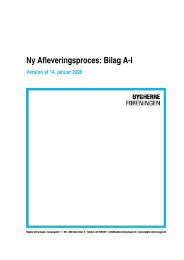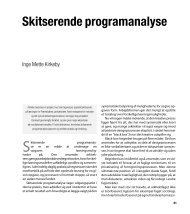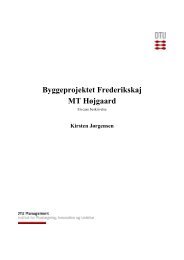Udvælgelses- dan og tildelingskriter ske byggesektor ... - RenProces
Udvælgelses- dan og tildelingskriter ske byggesektor ... - RenProces
Udvælgelses- dan og tildelingskriter ske byggesektor ... - RenProces
Create successful ePaper yourself
Turn your PDF publications into a flip-book with our unique Google optimized e-Paper software.
2006). As a part of the case study, an extensive amount of formal and informal<br />
interviews were conducted with several representatives from the clients’ organisation,<br />
from the project manager and from the skilled workers at the construction site.<br />
Furthermore, observations, participating observations and action research were carried<br />
out in order to understand and support learning activities at the site (Kristiansen and<br />
Kr<strong>og</strong>strup, 1999).<br />
The interviews were conducted as a pilot study in connection with a Ph.D.-project<br />
concerning the tender process and the selection of the project team 2 . The respondents<br />
were chosen to represent a broad range of roles in the building industry: the<br />
professional client (3 numbers of interviews), the architect (4), the engineer (4), and the<br />
contractor (4). 15 interviews were conducted covering both management and<br />
practitioners. The interviewed persons were all chosen as mid-level manager to get the<br />
most honest answers. The interviews were semi structured allowing the respondents to<br />
reflect on the questions and elaborate on their answers (B<strong>og</strong><strong>dan</strong> and Taylor, 1975). The<br />
main questions in the interviews were: How is the project team set under normal<br />
circumstances? What is the ideal way of setting a project team?<br />
3. FOCUS ON LEARNING AND COOPERATION<br />
In this section the case will be presented with the aim of showing how a client made a<br />
decision and took the first step to do something new with the objective of improving<br />
the building process.<br />
The client chose a team assigned on the basis of an architect project. The aim was to<br />
initiate a strategic partnering relationship (Bennet and Jayes, 1998) with the involved<br />
companies, starting with two projects without setting the second project to tender. By<br />
using the same team, the client believed both that the team members would invest in<br />
the cooperation among the different parties and the development of the building<br />
process, and that the experience gained in connection with the first project could be<br />
reused in the subsequent project. The overall objective was to increase the effectiveness<br />
and efficiency so the client would get a better quality at a lower price, and so the team<br />
members would benefit from the projects.<br />
The client took several initiatives in order to improve the cooperation and learning<br />
among the team members, such as the Last Planner System of Production Control<br />
(LPS) (Ballard, 2000) and such as focus on social arrangements with participation of all<br />
the involved parties. The project was also a part of a national initiative, BygSoL<br />
(Danish abbreviation for Leaning and Cooperation in the Building Industry, (Ebbesen<br />
and Olsen, 2006)). All of the above mentioned initiatives were introduced by the client<br />
because he believes in learning and cooperation as a way to improve the building<br />
process. By using the same team, the client believed that the initiatives would be a good<br />
investment and furthermore the client considered that the project would provide the<br />
building industry with some valuable experience.<br />
2 Ongoing PhD.-Project: <strong>Udvælgelses</strong>- <strong>og</strong> <strong>tildelingskriter</strong>ier i <strong>byggesektor</strong>en,<br />
(Selection- and assignment criteria in the Danish building sector), Lene Faber Ussing.<br />
197










